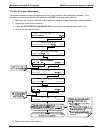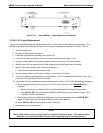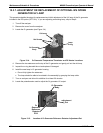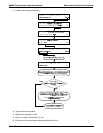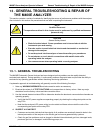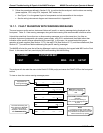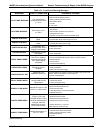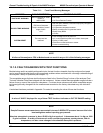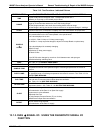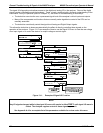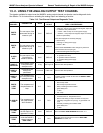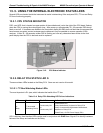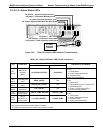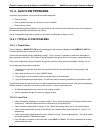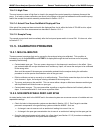
General Troubleshooting & Repair of the M400E Analyzer M400E Ozone Analyzer Operator’s Manual
Table 13-1: Front Panel Warning Messages
WARNING FAULT CONDITION POSSIBLE CAUSES
PHOTO REF WARNING
Occurs when Ref is <2500
mVDC or
>4950 mVDC.
UV Lamp
UV Photo-Detector Preamp
O3 GEN TEMP WARNING
IZS Ozone Generator
Temp is outside of control
range of 48C
3C.
No IZS option installed, instrument improperly configured
O3 generator heater
O3 generator temperature sensor
Relay controlling the O3 generator heater
Entire Relay Board
I
2
C Bus
SYSTEM RESET
The computer has
rebooted.
This message occurs at power on.
If it is confirmed that power has not been interrupted:
Failed +5 VDC power
Fatal Error caused software to restart
Loose connector/wiring
NOTE
A failure of the analyzer’s CPU or Motherboard can result in any or ALL of the following messages.
13.1.2. FAULT DIAGNOSIS WITH TEST FUNCTIONS
Besides being useful as predictive diagnostic tools, the test functions viewable from the analyzers front panel
can be used to isolate and identify many operational problems when combined with a thorough understanding of
the analyzers Theory of Operation (see Chapter 11).
The acce
ptable ranges for these test functions are listed in the “Nominal Range” column of the analyzer Final
Test and Validation Data Sheet shipped with the instrument. Values outside these acceptable ranges indicate a
failure of one or more of the analyzer’s subsystems. Functions whose values are still within acceptable ranges
but have significantly changed from the measurement recorded on the factory data sheet may also indicate a
failure.
A worksheet has been provided in Appendix C to assist in recording the value of these test functions.
NOTE
A value of “XXXX” displayed for any of these TEST functions indicates an OUT OF RANGE reading.
NOTE
Sample Pressure measurements are represented in terms of ABSOLUTE pressure because this is the
least ambiguous method reporting gas pressure.
Absolute atmospheric pressure is about 29.92 in-Hg-A at sea level. It decreases about 1 in-Hg per 1000
ft gain in altitude. A variety of factors such as air conditioning systems, passing storms, and air
temperature, can also cause changes in the absolute atmospheric pressure.
236 04315 Rev. C1



